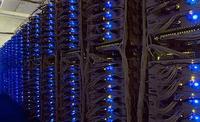-
Game lets players try their hand at computer security
A new game — Control-Alt-Hack — gives teenage and young-adult players a taste of what it means to be a computer-security professional defending against an ever-expanding range of digital threats; the game’s creators will present it this week in Las Vegas at Black Hat 2012; educators in the continental United States can apply to get a free copy of the game while supplies last; it is scheduled to go on sale in the fall for a retail price of about $30
-
-
Capturing CO2 directly from air is chemically, economically viable
With a series of papers published in chemistry and chemical engineering journals, researchers from the Georgia Institute of Technology have advanced the case for extracting carbon dioxide directly from the air using newly developed adsorbent materials
-
-
Pulling CO2 from air feasible, if still costly, way to curb global warming
Emerging techniques to pull carbon dioxide from the air and store it away to stabilize the climate may become increasingly important as the planet tips into a state of potentially dangerous warming; lower-cost technology is a stumbling block so far
-
-
New U.S. biodedfense R&D network launched
On Monday, Texas A&M System dedicated a new research center which is part of a national network of centers aiming to develop strategies and products to counter bioterrorism, chemical and radiological attacks on the United States, and better strategies to deal with pandemics; the network will have facilities in Texas, Maryland, and North Carolina; the Texas dedication is the culmination of a Manhattan Project-like program for biological countermeasures, launched in 2004 by the Department of Health and Human Services; the research network aims to develop “rapid, nimble and flexible approaches” to vaccine and therapy development, and train the next generation of professionals to sustain U.S. capabilities in these areas
-
-
You want to report a pothole? There’s an app for that

The city of Boston offers residents a new app – Street Bump – which will automatically report potholes they encounter; all the driver has to do is install the app and place the smartphone on the dashboard or in the cup holder; the app uses the phone’s motion detector and GPS locator to report potholes
-
-
Temperature rise, CO2 follow each other closely
The greatest climate change the world has seen in the last 100,000 years was the transition from the ice age to the warm interglacial period; new research indicates that, contrary to previous opinion, the rise in temperature and the rise in the atmospheric CO2 follow each other closely in terms of time
-
-
Selfish-herd theory confirmed

Many animals spend time together in large groups not because they enjoy each other’s company, but rather because it lowers their own chances of being eaten should an uninvited guest arrive on the scene — or so the theory goes; now, researchers who have strapped GPS-enabled backpacks to flocking sheep and a herding dog provide some of the first hard evidence that this “selfish herd theory” is true
-
-
Engineering students race first 3-D printed boat in Milk Carton Derby

University of Washington mechanical engineering students braved uncharted waters as they paddled to the finish line at the annual Milk Carton Derby at Green Lake in Seattle in what they believe is the world’s first boat made using a 3-D printer
-
-
Milestone for a Raytheon bomb which acquires, tracks, and then hits moving targets
Raytheon said its Small Diameter Bomb II (SDB II) program achieved a milestone when it successfully engaged and hit a moving target during a flight test at the White Sands Missile Range, New Mexico; the bomb, released from an F-15E, acquired, tracked, and guided to a moving target using its tri-mode seeker, scoring a direct hit
-
-
Replacing coal with natural gas would reduce global warming
A new study finds that a gas substitution scenario, in which natural gas replaces all coal power production and any new oil-powered facilities by midcentury, would realize 40 percent of the reduction in global warming that could be achieved with a full switch to low-carbon fuel sources; this is a less costly, and more feasible, option, than switching all electricity generation immediately and aggressively to non-fossil fuel sources such as solar, wind, and nuclear
-
-
Using dolphins’ signal processing method for sea-mine detection

One way for Iran to close the Straits of Hormuz to shipping is to place thousands of sea mines in the water; research examine how dolphins process their sonar signals, using the findings to provide a new system for man-made sonar to detect targets, such as sea mines, in bubbly water
-
-
Per capita CO2 emissions in China reach EU levels
Global emissions of carbon dioxide (CO2) increased by 3 percent last year; an estimated cumulative global total of 420 billion tons of CO2 has been emitted between 2000 and 2011 due to human activities, including deforestation; scientists suggest that in order to limit the rise in average global temperature to 2°C above pre-industrial levels, cumulative CO2 emissions in the period 2000–50 cannot do not exceed 1,000 to 1,500 billion tons
-
-
New method for detecting, measuring bridge damage
Researchers have created a bridge health index, which is a rating system that more accurately describes the amount of damage in a bridge; the health index can extend beyond bridges and apply to other structures, such as gas pipelines, dams, buildings, and airplanes
-
-
Cutting massive power use at big data companies in a flash

Big data needs big power; the server farms that undergird the Internet run on a vast tide of electricity — Google, for example, uses enough electricity in its data centers to power about 200,000 homes; now, a team of engineers has a solution that could radically cut that power use — a new type of memory in companies’ servers that demands far less energy than the current systems
-
-
New rapid diagnostic test for pathogens, contaminants developed
Using nanoscale materials, researchers have developed a single-step method rapidly and accurately to detect viruses, bacteria, and chemical contaminants; the method could be used to detect pathogens and contaminants in biological mixtures such as food, blood, saliva, and urine
-
More headlines
The long view
New Technology is Keeping the Skies Safe
DHS S&T Baggage, Cargo, and People Screening (BCP) Program develops state-of-the-art screening solutions to help secure airspace, communities, and borders
Factories First: Winning the Drone War Before It Starts
Wars are won by factories before they are won on the battlefield,Martin C. Feldmann writes, noting that the United States lacks the manufacturing depth for the coming drone age. Rectifying this situation “will take far more than procurement tweaks,” Feldmann writes. “It demands a national-level, wartime-scale industrial mobilization.”
How Artificial General Intelligence Could Affect the Rise and Fall of Nations
Visions for potential AGI futures: A new report from RAND aims to stimulate thinking among policymakers about possible impacts of the development of artificial general intelligence (AGI) on geopolitics and the world order.
Smaller Nuclear Reactors Spark Renewed Interest in a Once-Shunned Energy Source
In the past two years, half the states have taken action to promote nuclear power, from creating nuclear task forces to integrating nuclear into long-term energy plans.
Keeping the Lights on with Nuclear Waste: Radiochemistry Transforms Nuclear Waste into Strategic Materials
How UNLV radiochemistry is pioneering the future of energy in the Southwest by salvaging strategic materials from nuclear dumps –and making it safe.
Model Predicts Long-Term Effects of Nuclear Waste on Underground Disposal Systems
The simulations matched results from an underground lab experiment in Switzerland, suggesting modeling could be used to validate the safety of nuclear disposal sites.
